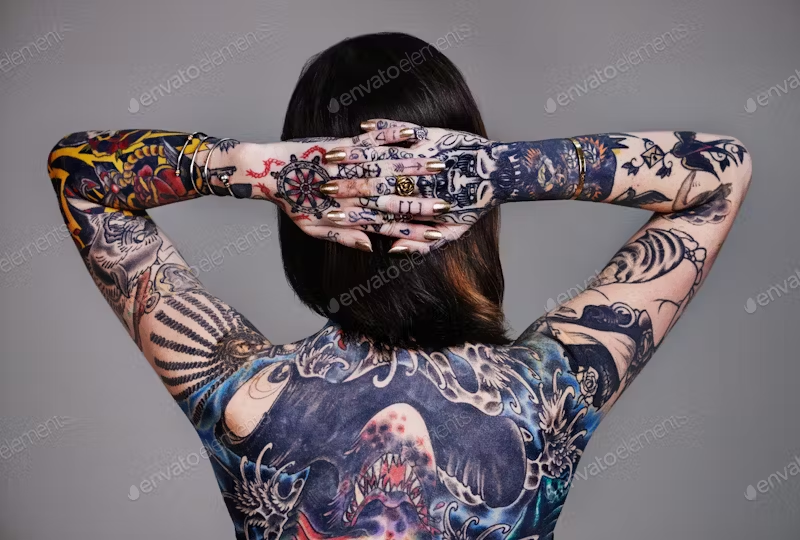Contents
world of tattoos and their composition!
Imagine your skin as a blank canvas, ready to tell a story. Tattoos are like colorful paint on that canvas, but instead of fading away like regular paint, they stick around for a long time. So, how do they do that? Let’s break it down.
First off, what are tattoos made of? Well, they’re crafted from tiny, colored particles called pigments. These pigments are mixed into a kind of ink that’s specifically made for tattooing. Picture it like a recipe, but instead of making a cake, you’re making art on your skin!
Now, how does this ink get into your skin? That’s where the tattoo artist comes in. They use a special tool called a tattoo machine, which works a bit like a sewing machine, but instead of needles sewing fabric, it’s poking tiny holes in your skin. Sounds a bit scary, but don’t worry, it’s not as painful as it sounds!
As the tattoo machine gently punctures your skin, it deposits those pigments into the deeper layers. This is important because if the ink only went into the top layer, it would fade away quickly, like doodles in the sand. But by going deeper, it’s like planting seeds that grow into a colorful garden.
Now, here’s where the magic of “tattoo stretch” comes in. Your skin is like a rubber band—it can stretch and shrink depending on things like weight gain, muscle growth, or even pregnancy. When your skin stretches, those tattoo pigments stretch with it, like colorful elastic bands. This is why tattoos can look a bit different on your body as time goes by.
But why do tattoos seem so permanent? Well, it’s because those pigments are nestled snugly in the middle layer of your skin, called the dermis. This layer doesn’t shed cells like the outer layer, so the ink stays put. It’s like burying treasure deep underground—it’s not going anywhere!
So, that’s the magic of tattoos—they’re like colorful stories etched into your skin, ready to stretch and bend with you as you journey through life.
Skin Elasticity and Tattoo Placement
Picture your skin as a super-stretchy fabric that covers your body. But here’s the thing: not all parts of this fabric stretch the same way. Some areas are like rubber bands, while others are more like stiff cardboard. This is what we call “skin elasticity.”
Now, when you decide to get a tattoo, where you put it on your body can make a big difference. Let’s say you want a cool design on your arm. Arms? They’re like stretchy rubber bands, able to bend and move with ease. But what about your tummy? That’s a bit more like stiff cardboard, especially if you’ve got a lot of muscles or extra padding.
So, why does this matter for your tattoo? Well, think about stretching a picture on a rubber band versus on cardboard. On the rubber band, the picture stretches along with it, staying mostly the same. But on the cardboard, it might get a bit wrinkled or distorted.
The same goes for tattoos. If you put one on a stretchy part of your body like your arm or leg, it can stretch and move with your skin. But if you ink up a less elastic area like your belly or chest, the tattoo might stretch out more over time. This stretching can make the lines blur or the colors fade, kind of like a painting that’s been tugged at too much.
So, when picking the perfect spot for your tattoo, think about how much it might stretch and how that could affect the design. And remember, no matter where you put it, your tattoo will always be a unique part of your story, stretch marks and all!
Impact of Weight Fluctuations on Tattoos
Let’s talk about how changes in body weight can affect your tattoos. Think of your skin like a balloon. When you blow it up or let the air out, the pictures on it change shape. This is a bit like what happens to your tattoos when your body weight changes.
When you gain weight, your skin stretches to make room. If you have a tattoo in an area where you gain a lot of weight, like your stomach, thighs, or arms, the tattoo stretches too. This “tattoo stretch” can make the design look bigger and sometimes distorted. Lines that were once straight might become wavy, and shapes might look a little different.
On the flip side, when you lose weight, your skin shrinks. If you’ve had a tattoo stretch because of weight gain and then lose that weight, the tattoo might shrink back, but it often doesn’t look exactly the same as before. The skin might be a bit looser, and the tattoo could look a bit saggy or wrinkled.
Areas prone to a lot of stretching, like your belly, hips, and upper arms, are where you’ll notice these changes the most. Tattoos in these spots are more likely to stretch out and then shrink back, changing the way they look over time.
To keep your tattoos looking their best, try to maintain a stable weight. Rapid weight gain or loss can cause a lot of tattoo stretch, which can make your ink look different from what you originally wanted. If you’re planning a significant change in your weight, it’s something to keep in mind before getting a new tattoo.
So, remember, your body is like a dynamic canvas. As it changes, so will your tattoos. Embrace the journey, and let your tattoos stretch and evolve with you!
Pregnancy and Tattoos
Pregnancy is an incredible journey that brings many changes to your body, and if you have tattoos, you might wonder how they will be affected. Imagine your skin as a flexible canvas, and your tattoos as the artwork on it. As your body changes shape during pregnancy, this artwork might stretch and shift.
One of the most common areas where tattoos stretch during pregnancy is the belly. As your baby grows, your skin stretches to accommodate the new life inside you. This means any tattoos on your stomach will also stretch. This “tattoo stretch” can make designs look larger or distorted. For example, a small flower might bloom into a bigger, less detailed version of itself, and straight lines might start to curve.
The same goes for areas like the hips, thighs, and breasts, which can also experience significant stretching. Tattoos in these spots might stretch out and change shape, just like on your belly. This is all part of the natural process of your body adapting to pregnancy.
But don’t worry—many women find that their tattoos return to near their original shape after they give birth and their bodies return to their pre-pregnancy state. However, the skin might not be exactly the same as it was before, so the tattoos might still look a little different. They might be slightly stretched out or have a different texture.
To keep your skin healthy and minimize tattoo stretch, it’s important to stay hydrated and use moisturizers. This can help your skin stay as elastic as possible. After your baby is born, gentle skincare and sometimes even professional treatments can help your skin recover.
So, if you’re expecting and have tattoos, just know that your body is going through an amazing transformation. Your tattoos might stretch and change, but they will always be a part of your unique journey, telling a story of the incredible changes your body has gone through. Embrace the tattoo stretch as a beautiful reminder of this special time in your life!
Muscle Growth and Tattoos
Let’s explore how muscle growth and bodybuilding can affect your tattoos. Think of your skin as a stretchy canvas, and your tattoos as the artwork on it. When you build muscle, this canvas stretches to fit the new muscle size, leading to what we call “tattoo stretch.”
When you work out and your muscles grow, especially in areas like your arms, chest, and legs, your skin stretches to cover the bigger muscles. This “tattoo stretch” can cause the design to change shape. For example, if you have a tattoo on your bicep and you start lifting weights regularly, your bicep will get bigger, and the tattoo will stretch out. A circular tattoo might become more oval, and straight lines could start to curve.
The same thing happens with tattoos on your chest, back, and thighs. As these muscles grow, the skin over them stretches, which can distort the tattoo. This doesn’t mean your tattoo will be ruined, but it might look different than it did before you started building muscle.
Most tattoos can handle a bit of stretch without looking too different. Your skin is quite elastic and can adapt to changes in your body. However, rapid and significant muscle growth can cause more noticeable changes. If you’re planning to bulk up a lot, it’s something to keep in mind when choosing where to place your tattoo.
To minimize unwanted tattoo stretch, think about placing tattoos on parts of your body less likely to experience dramatic muscle growth, like your upper back, forearm, or calf. These areas are less prone to major changes, so your tattoo will stay closer to its original shape.
So, if you’re into bodybuilding and thinking about getting a tattoo, or if you already have tattoos and plan to hit the gym hard, remember that your body is a dynamic canvas. As your muscles grow and your body changes, your tattoos will stretch and evolve with you, adding to the story they tell. Embrace the journey and the tattoo stretch that comes with it!
Aging and Tattoo Distortion
Let’s delve into how aging affects your tattoos. Think of your skin as a flexible canvas, and your tattoos as the beautiful artwork on it. Over time, as you age, this canvas changes, and this can cause what we call “tattoo stretch” and distortion.
As you get older, your skin naturally loses some of its elasticity. Imagine a rubber band that’s been stretched out too many times—it doesn’t snap back like it used to. This is similar to what happens to your skin. It becomes thinner and less firm, which can cause your tattoos to stretch and change shape.
Tattoos that were once crisp and vibrant might start to blur and fade. Lines that were sharp can become fuzzy, and colors might not be as bright as they once were. This is because the skin isn’t as taut as it used to be, causing the ink to spread slightly. For example, a detailed tattoo on your forearm might look a bit smudged or less distinct as the years go by.
Areas of your body that experience a lot of movement, like your hands, elbows, and knees, might show more tattoo stretch and distortion. These parts of your body are constantly bending and stretching, which can make tattoos in these areas change more noticeably over time.
On the other hand, tattoos in areas with thicker skin, like your back or thighs, might hold up better. These areas are less prone to constant movement and stretching, so the tattoos there might remain clearer for longer.
Taking good care of your skin can help slow down the aging process and minimize tattoo stretch. Keeping your skin moisturized, using sunscreen, and staying hydrated are all good practices. Healthy skin retains its elasticity better, which helps keep your tattoos looking their best.
So, as you age, remember that your tattoos are part of your journey. They might stretch and change with your skin, but they continue to tell your story. Embrace the changes, and appreciate the way your tattoos evolve with you over time.
Preventing Tattoo Distortion
Getting a tattoo is like adding a beautiful piece of art to your body, and you want it to stay looking great. But over time, your skin can stretch and change, leading to what we call “tattoo stretch.” Here are some simple tips to help minimize the risk of tattoo distortion and keep your ink looking fresh.
1. Choose the Right Placement
Stable Areas: Choose places on your body that don’t change much over time. Areas like your upper back, forearms, and calves are less likely to stretch significantly. These spots can help your tattoo stay true to its original design.
Avoid High-Stretch Zones: Be cautious about tattooing areas prone to a lot of stretching, like your stomach, inner thighs, or biceps, especially if you plan on major weight changes or muscle growth. These areas are more likely to experience tattoo stretch.
2. Maintain a Stable Weight
Consistency is Key: Keeping your weight stable helps prevent major skin stretching or shrinking. Rapid weight gain or loss can cause your skin to stretch out or become loose, distorting your tattoo.
Healthy Lifestyle: Eating a balanced diet and exercising regularly can help you maintain a stable weight, reducing the risk of tattoo stretch.
3.Skin Care is Essential
Moisturize Regularly: Keeping your skin hydrated helps maintain its elasticity. Use a good moisturizer daily to keep your skin soft and supple.
Sun Protection: The sun’s UV rays can damage your skin and fade your tattoo. Always apply sunscreen on your tattoo when you’re out in the sun to protect both your skin and your ink.
4. Consider Future Changes
Pregnancy: If you’re planning on having children, remember that pregnancy can cause significant skin stretching, especially on your abdomen. Consider this when choosing tattoo placement.
Aging: As you age, your skin naturally loses elasticity. Areas that age more gracefully, like your upper back or forearms, might be better spots for your tattoo.
5. Consult with a Professional
Tattoo Artist Advice: Experienced tattoo artists can offer valuable advice on placement and design to minimize the risk of tattoo stretch. They can help you choose spots that are less prone to distortion.
Regular Touch-Ups: Sometimes, a touch-up can restore your tattoo’s original look. Consult your tattoo artist about touch-ups to keep your ink looking fresh.
By following these tips, you can help prevent tattoo stretch and keep your body art looking its best. Remember, your tattoo is part of your story, and taking care of it will help it stay a beautiful part of your journey.





